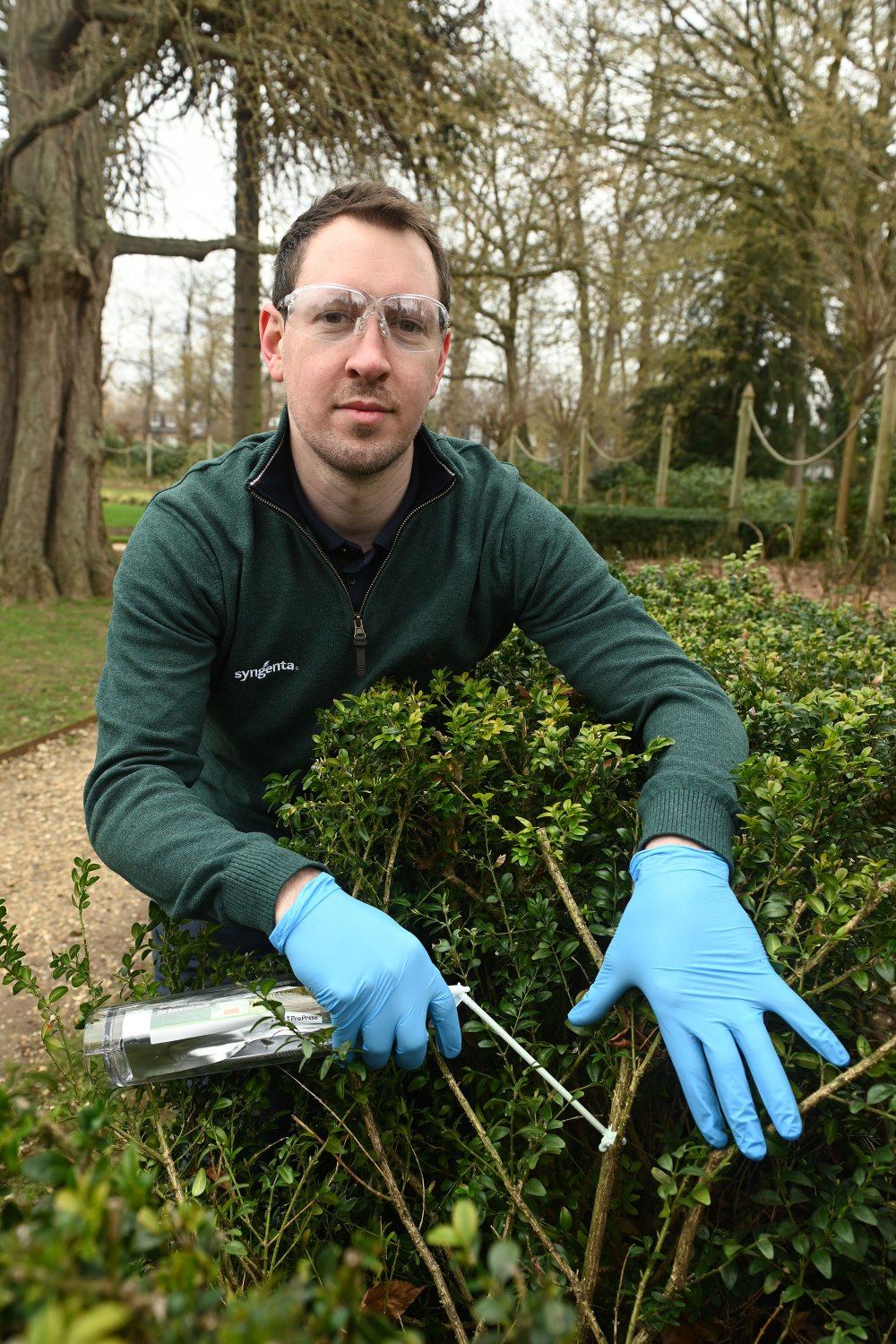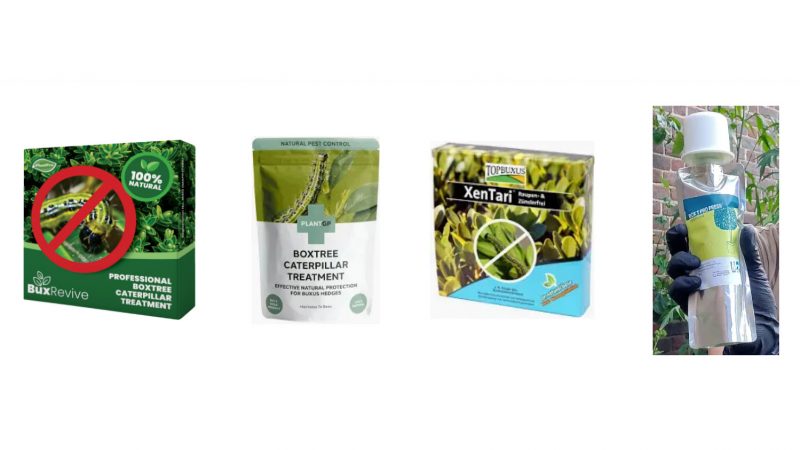UK Professional’s BTM Mating Disruption
New strategy to protect from box tree caterpillars
Gardeners and landscapers should be on the lookout for the first sign of box tree caterpillar activity as soon as temperatures consistently reach around 10⁰C this spring, and have traps in place to pick up very first moth emergence.
A new box tree moth control strategy, integrating the sexual disruptor pheromone, Box T Pro Press, is now widely available across the UK and offers an exciting opportunity to protect the iconic garden species, according to leading box tree specialist, Chris Poole of the European Boxwood and Topiary Society (UK).
“The first thing you might see is ‘windowing’ of leaves, as caterpillars that have overwintered within a folded leaf, eat their way out,” he advised. “Caterpillars are capable of withstanding temperatures down to minus 30⁰C, so even this cold winter will have had little impact.”
Caterpillars can feed voraciously on leaves within the tree structure, only becoming apparent when they reach the outer layers – by which time extensive damage could have occurred, he warned.
A passionate campaigner for the benefits of box over any of the suggested alternatives, Chris urges any gardener not to grub out box trees, even if they have suffered from caterpillar damage or blight in previous seasons.
“Box trees have a remarkable ability to withstand damage and recover to their full glory, providing they can be protected from repeated damage every year.”
Having pioneered the use of new mating disruptor pheromone control techniques on the National Trust’s world-renowned Ham House box displays, Chris has now taken on the task of helping to restore the historic Grade 1 gardens of Chiswick House & Gardens in west London where he is a Specialist Volunteer working with the garden team under the guidance of Head Gardener, Rosie Fyles.
The Chiswick gardens includes extensive lengths of box hedging, blocks of box, individual topiary trees and some ancient trees up to 4m high and possibly 200 years old, or more. While some have been lost to heavy infestations of box tree moth, with judicious pruning and clearing, planting new seedlings and better protection of the remaining plants, he believes the former structure and legacy of the box can be restored.
Chris’ strategy to protect the box will involve a spray treatment of Bacillus thuringiensis (Bt) at the first signs of caterpillar activity, following up with placing pheromone monitoring traps around the garden.
“The aim of the Bt spray is to clear up as many of the overwintered caterpillars as possible,” he advocated. “Bt really is our favoured option for spraying since it is so well targeted at the box tree caterpillar and no effect on non-target organisms or other biodiversity in the gardens.
“However, it’s not persistent, so you need to repeat the programme of spraying regularly through the season to get good levels of control. That’s a real commitment and, if there is any disruption from weather or a spray missed, the pest numbers can proliferate.”
To better protect the box through the whole season, this year he will introduce Box T Pro Press mating disruptor pheromone just before, or at very first signs, of adult box tree moth. Applied discreetly within the tree canopy, the product emits a pheromone that sexually confuses the male moths, such that they cannot find a female to mate.
Preventing the laying of fertile eggs, the breeding cycle of the moth is broken and stops subsequent hatches of caterpillars.
“When we introduced the technology at Ham House the results were very good,” Chris reported. “The use of the Bt spray regime was reduced from eight applications per season, to just three and some of those were targeted at localised outbreaks two. And the levels of damage experienced in the box was also markedly reduced.”
Two applications of Box T Pro Press are used, three months apart, to cover the whole season.
A second Bt application may be required, but only if caterpillar activity is identified, or at the end of the season as a final clean up. Chris highlights the importance of clearing fallen vegetation from around the base of box hedging, providing a slow-release fertiliser including trace element nutrients and adapting the thinning regime to encourage growth in the centre of the plant will all encourage recovery and healthy box.
“Box is such a valuable and statuesque plant to have in the garden,” he enthused. “There is nothing available that gives the same appearance, with all of the promoted alternatives presenting some serious challenges in their management or garden design. With the technology now available, there is no reason not to have clean and healthy box.”
Syngenta Technical Manager, Sean Loakes, outlined that Box T Pro Press is now available for professional gardeners and landscapers providing domestic garden management.
“It has given exceptional results since its launch in southern Europe. With box tree moth continuing to spread north and west each season in the UK, it’s a timely chance to prevent further damage and protect every tree.”
He highlighted that professional operators could apply the product quickly and cost effectively. It’s supplied in a 250-dose pouch, which fits into a purpose designed applicator pumped up with compressed air. A trigger release applies a small coin-sized dose to the stem or branch within the box tree canopy.
The wax base formulation quickly dries and then emits the pheromone gradually over a three-month release period. A dose is applied every two meters of hedge, or three dosses per cubic meter of box, to create a zone of saturated pheromones to confuse the male moths and protect the trees.
“Using compressed air to power the pump eliminates any chemical propellant and is easy to apply,” advised Sean. “Since the pheromone contained in Box T Pro Press only affects the box tree moth, it fits perfectly with the garden’s ethos of preventing any impact on wider biodiversity.”
Tree care field expert, Xavier Glinec of French biocontrol specialists, M2i, reported research since 2017 in some of the most prestigious ornamental gardens in France had seen a 10 times reduction in box tree moths through the season in areas treated with Box T Pro Press, compared to untreated, along with a two to four times reduction in caterpillars.
“At Château de Bouysses in south west France, for example, monitoring caught no moths throughout the season in the treated areas, compared to eight moths per trap in the untreated area at the end of August,”
The site also saw an 80% reduction in caterpillar numbers over the season.
A further trial under high pest pressure at Château de Bouges resulted in no caterpillars being observed and no moths caught in the traps. “The box trees are now in excellent condition,” Xavier reported.
Sean Loakes added:
“The combination of Box T Pro Press, pest monitoring and biological insecticide use is a perfect example of a genuine IPM approach, which has immense potential for control of damaging box tree moth in gardens. The strategy could help ensure box remains a key feature in gardens across the UK.”
Box T Pro Press is available now from professional horticulture specialists and advisors, Fargro.
- Demonstrating application in a hedge
- How to apply in a topiary
- Discussing dosage for an area of box
- Appling Box T Pro Press to the plant
- Chris Poole - EBTS UK
- Sean Loakes - Syngenta
- Xavier, M2i
About Syngenta
Syngenta is one of the world’s leading agriculture companies, comprised of Syngenta Crop Protection and Syngenta Seeds. Our ambition is to help safely feed the world while taking care of the planet. We aim to improve the sustainability, quality and safety of agriculture with world class science and innovative crop solutions. Our technologies enable millions of farmers around the world to make better use of limited agricultural resources. Syngenta Crop Protection and Syngenta Seeds are part of Syngenta Group. In more than 100 countries we are working to transform how crops are grown. Through partnerships, collaboration and The Good Growth Plan we are committed to accelerating innovation for farmers and nature, striving for regenerative agriculture, helping people stay safe and healthy and partnering for impact.
About Syngenta TreeCare
Syngenta produces world leading tree care products, designed for long-term, effective and sustainable protection of tree health. Syngenta invests over $1.2bn a year in R&D of proven products, which include the development of high-performance fungicides, insecticides biocontrols and plant health enhancements.
Many Syngenta TreeCare products are derived from the naturally occurring biocides; refined into highly effective pest and disease control options. Innovative Syngenta application technology and support advice enables the optimum results from every treatment.
The Syngenta approach seeks to balance science and nature to evolve an exciting future for TreeCare – where every tree counts.
For further information please contact:
Syngenta Turf & Landscape Syngenta Tree Care
EAME Lead
Sean Loakes
sean.loakes@syngenta.com
Kym Kis
kym.kis@syngenta.com
European Boxwood and Topiary Society (UK)
Chris Poole
info@ebts.org
TOP PR
Mark Sanderson
mark.s@toppr.co.uk











